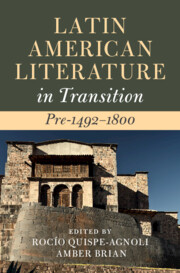Book contents
- Latin American Literature in Transition Pre-1492–1800
- Latin American Literature in Transition
- Latin American Literature in Transition Pre-1492–1800
- Copyright page
- Dedication
- Contents
- Figures
- Contributors
- Acknowledgments
- Introduction Dwelling in Transitions
- Part I Land, Space, Territory
- Part II Body
- Part III Belief Systems
- Part IV Literacies
- Chapter 14 Transcultural Intertextuality in Colonial Latin America
- Chapter 15 Becoming a Book: The Reproduction, Falsification, and Digitalization of Colonial Codices
- Chapter 16 From Print to Public Performance to Relaciones de fiestas: Don Quixote in Viceregal Festivals
- Chapter 17 Colonial Latin American Bibliography and the Indigenous Text
- Part V Languages
- Part VI Identities
- Index
- References
Chapter 15 - Becoming a Book: The Reproduction, Falsification, and Digitalization of Colonial Codices
from Part IV - Literacies
Published online by Cambridge University Press: 25 November 2022
- Latin American Literature in Transition Pre-1492–1800
- Latin American Literature in Transition
- Latin American Literature in Transition Pre-1492–1800
- Copyright page
- Dedication
- Contents
- Figures
- Contributors
- Acknowledgments
- Introduction Dwelling in Transitions
- Part I Land, Space, Territory
- Part II Body
- Part III Belief Systems
- Part IV Literacies
- Chapter 14 Transcultural Intertextuality in Colonial Latin America
- Chapter 15 Becoming a Book: The Reproduction, Falsification, and Digitalization of Colonial Codices
- Chapter 16 From Print to Public Performance to Relaciones de fiestas: Don Quixote in Viceregal Festivals
- Chapter 17 Colonial Latin American Bibliography and the Indigenous Text
- Part V Languages
- Part VI Identities
- Index
- References
Summary
This article discusses the transitional nature of early Mesoamerican codices and their evolving status within the field of colonial Latin American literary studies. It does so by (1) exploring the physical and intellectual journeys of the original texts, a process characterized by historically conditioned forms of visual and textual literacy and by the often-divergent interests and goals of the individuals and institutions who came into contact with them; and (2) interrogating the displacements introduced by historical attempts at reproducing them in other formats and media and expanding the corpus through falsification. This chapter’s discussion allows for a revaluation of the way through which these texts came to occupy a place in the contemporary understanding of the colonial literary canon and the role they play in defining a field in transition.
Keywords
- Type
- Chapter
- Information
- Latin American Literature in Transition Pre-1492–1800 , pp. 228 - 242Publisher: Cambridge University PressPrint publication year: 2022

